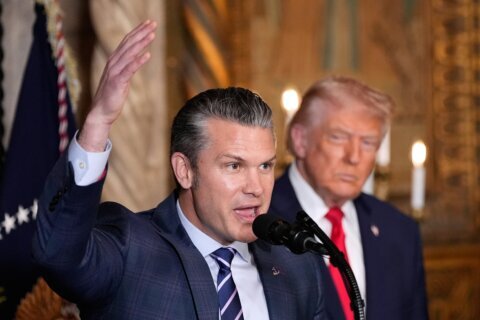Once it was clear that then-Sen. Kamala Harris would become vice president, there was talk of what to call her husband, Doug Emhoff, as he stepped into a role played exclusively by women: that of second spouse.
The first order of business was determining the title. While Vice President Harris joked that she’d still be calling Emhoff “honey,” she said the title “second gentleman” had been decided upon.
Next, what role should Emhoff take on?
Kelly Dittmar, associate professor of political science and director of research at the Center for American Women and Politics at Rutgers University, said that just like any second lady, Emhoff will be expected to work on a particular issue.
It may be something he himself is passionate about, but, Dittmar said, “I think if we’re being pretty honest, it’s usually what the administration needs him to do.”
Dittmar said that has been true of other first and second ladies. They’ve been expected to find ways to promote causes or address issues that enhance the administration’s positions and meet the demands of the country at that moment.
The second lady also has had to keep in mind that she must not overshadow her spouse, or the first lady.
When Barack Obama was president, his wife Michelle worked closely with then-second lady Dr. Jill Biden. The two seemed to have a genuine partnership, said Dittmar.
“I expect that we’ll see much of that from Doug Emhoff and Jill Biden,” said Dittmar. “From what they’ve shown on the campaign trail thus far, they seem to be genuinely friendly to each other and want to work together.”
However, Dittmar said the second gentleman will have to remember that the first lady has a more prominent role.
“That’s just the hierarchy of the White House.”
Dittmar said Emhoff seems to understand that while he’s unique in that he’s the first man to serve as second spouse, he has something to learn from the women who filled the job first.
“There’s a real understanding that he’s not creating a new role. One of the things he’s been very clear to do, and careful to do, is to say that he’s building on the work of the many women who held this position before him,” said Dittmar, pointing out Emhoff’s stop at the Library of Congress, where he was shown getting a tour along with some history lessons.
Emhoff may be the first man to fill the role of second gentleman, but he’s already getting the kind of treatment many prominent American women do, in that his fashion choices have been written about and scrutinized.
“When we talk about fashion and appearance, it can certainly become sexist, but there are ways in which, for example, especially women in politics use fashion to make a political statement,” said Dittmar.
Women in modern political life may make statements by choosing to wear clothing by an American designer or wearing white as the women of the suffragist movement of the early 20th century did.
“When we report on what the men are wearing too, in some ways that’s equity,” she said with a laugh, noting that women’s fashion choices, whether they’re politicians or politicians’ spouses, have often been the initial focus of their public life.
Dittmar was asked about how her students at Rutgers see the role of the first second gentleman.
“I guess as a credit to our progress. I don’t think they see it as unusual as we would have 10, 20, 30 years ago.”








